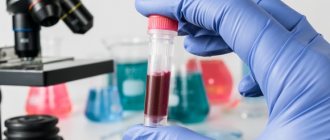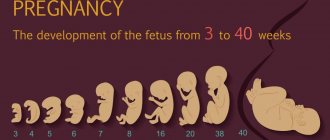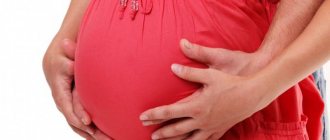- Do not physically overstrain your body for several days; limit your intake of protein foods, eat a maximum of 200 grams of meat or fish products the day before the test; do not drink coffee and alcohol; drink enough water (at least one and a half liters per day).
A low level of creatinine in the blood can either mean nothing or be a harbinger and sign of serious illness. It is up to the doctor to establish the reasons for its decrease. If it is not caused by diseases, then returning the normal level of this metabolite in the blood is not at all difficult. You need to exercise more, get enough sleep, eat well and your creatinine will be fine again.
Source: https://onwomen.ru/kreatinin-ponizhen.html
Why is the level higher than normal?
An increase in level is usually caused by the following:
- Severe kidney damage (for example, due to malignancy) or chronic kidney disease;
- Dehydration;
- Muscle injuries;
- Low blood pressure;
In women, high creatinine clearance levels are often symptoms of pregnancy .
An abnormal nitrogen to creatine ratio may indicate severe dehydration or bleeding in the gastrointestinal tract.
Frequent symptoms of elevated levels:
- Weakness;
- Dyspnea;
- Increased fatigue;
- Dehydration.
Reasons for the increase
In clinical practice, an upward change in creatinine levels is more common. A persistent increase leads to shortness of breath, fatigue due to moderate physical or mental stress, disturbance of the psycho-emotional state, and exhaustion.
Elevated creatinine in the blood allows us to give an objective assessment of the function of the kidneys and organs of the genitourinary system
- kidney damage of various nature with deterioration of their function;
- chronic kidney failure;
- metabolic disorders of any origin;
- changes in water and electrolyte balance;
- pathologies of muscle tissue;
- arterial hyper- or hypotension.
If creatinine increases, along with an increase in residual nitrogen, dehydration and internal bleeding are suspected. An increase in creatinine clearance is observed in pregnant women.
Why is the level below normal?
Muscular dystrophy or aging leads to a decrease in muscle mass, which will be indicated by a low level of creatinine in the blood. If the patient is on a low protein diet or is a vegetarian, the level will be below normal. During pregnancy, a decrease in creatinine levels is also observed.
Low levels of creatinine clearance indicate chronic kidney disease. Often such serious damage is caused by the development of malignant neoplasms, poor blood flow to the kidneys, or blockage of the urinary tract, dehydration, or heart failure.
Nitrogen to Creatine Ratio: Low levels are usually associated with a low protein diet, severe muscle injury, pregnancy, Parhon's syndrome. Sometimes, due to lung disease, diseases of the central nervous system, or taking antibiotics, these indicators also fall.
Norms during pregnancy:
| Third trimester | |||
| Creatinine, mg/dl | 0,4-0,7 | 0,4-0,8 | 0,4-0,9 |
| µmol, l | 35-62 | 35-71 | 35-80 |
Effective renal plasma flow increases during pregnancy by 50-70% (the change is most pronounced in the first two trimesters). The increase in glomerular filtration rate peaks around the 13th week of pregnancy, and the GFR level in a pregnant woman can be 150% of the normal level.
Creatinine clearance testing is often used to monitor the progression of diabetic kidney disease.
High glucose levels are often the cause of diabetic nephropathy, which leads to kidney failure. The latter develops in 50% of patients with type 1 diabetes within 10 years. In 20% of patients suffering from type 2 diabetes mellitus, it develops within 20 years. Patients with diabetes must monitor their glucose levels and blood pressure to reduce the risk of developing kidney failure.
Microalbuminuria is considered one of the best screening tools for the early stages of nephropathy. After kidney damage, small amounts of protein leak into the urine, called microalbuminuria. Experts from the American Endocrinology Research Center recommend that patients with diabetes begin monitoring the level of microalbuminuria as early as possible.
Microalbuminuria is a very sensitive test in people with type 1 diabetes, but the test may not be accurate in people with type 2 diabetes. For this reason, to diagnose the disease, the doctor advises taking a test for glomerular filtration rate (GFR), a measure of the body's elimination of end products in urine. The higher the creatinine level, the lower the GFR; low levels of this indicator confirm kidney disease.
The effect of creatinine levels on the kidneys
The level of creatinine in the blood reflects the functional activity of the kidneys. Since this substance is excreted only in the urine, an increase in the amount of creatinine in a biochemical blood test should cause concern in both women and men.
Achieving indicators up to 300 µmol/l. occurs when the kidneys are not able to remove the amount of substance that was formed during human life.
However, it should be borne in mind that indicators begin to increase when the process of death of kidney tissue is in full swing. Therefore, this analysis is not practical for early detection of chronic renal failure.
Source: vseanalyzy.com
How to normalize the level?
Some useful tips:
- Some types of herbal tea can be consumed to reduce the amount of creatinine. This tea usually contains nettle leaf and dandelion root, but regular green tea will also work. These teas stimulate the kidneys, increasing the amount of urine produced. Consequently, more product will be excreted from the body through urine.
- Nettle contains histamines and plant compounds that help increase blood flow to the kidneys, thereby increasing urine filtration. Nettle can be taken as a dietary supplement.
- Sage increases the glomerular filtration rate. It contains magnesium extract, which promotes the development of kidney function.
- It is necessary to reduce the consumption of foods rich in protein. The limit should be 0.4 grams per 500 grams of weight.
- Limit sodium intake to 2.4 grams per day. To do this, it is necessary to exclude foods such as meat, chips and fast food, salty spicy and fried foods, and increase the amount of fresh vegetables and fruits, seafood, pasta, rice and milk.
- You need to drink at least 1.5 liters of clean water per day.
- Reduce your level of physical activity.
- Healthy sleep.
Before following any of the above tips, you should consult your doctor .
These tests can always be taken in any laboratory, regardless of the city. For example, in the independent diagnostic laboratory INVITRO.
Prices for tests vary depending on which laboratory is chosen.
The approximate cost of a creatinine test is from 200 to 300 rubles, and a creatinine clearance test is from 300 to 400 (together with urine testing, the price will increase by approximately 200 rubles).
To determine the ratio of nitrogen to creatine, you need to take a blood biochemistry test: extended profile, or minimal profile, the price for such a test ranges from 3,000 to 5,000 rubles.
The tests will be ready in 1 business day, or urgently in 2 hours (the cost is higher).
Microalbuminuria is a very sensitive test in people with type 1 diabetes, but the test may not be accurate in people with type 2 diabetes. For this reason, to diagnose the disease, the doctor advises taking a test for glomerular filtration rate (GFR), a measure of the body's elimination of end products in urine. The higher the creatinine level, the lower the GFR; low levels of this indicator confirm kidney disease.
Analysis of urine
Considering that creatinine is excreted from the body exclusively with urine, studying the biochemical composition of urine increases the information content of laboratory studies. There are two main tests for determining creatinine in urine:
- Study of daily urine. The first portion after waking up is drained, and the rest is collected in a sterile jar during the day. During sampling, salt is reduced, meat and physical activity are excluded. Women are advised to drink plenty of clean water throughout the day. Determination of creatinine concentration in urine takes one day.
- Rehberg's test. Rehberg's test is the same daily test that determines creatinine clearance, or the glomerular filtration rate of the kidneys - an indicator of the volume of blood that the kidneys can cleanse per day. The clearance rate in women varies between 90–130 ml/min.
Creatinine in urine is an important criterion for assessing not only the function of the kidneys and urinary system, but also the heart, muscle structures, liver, in conjunction with other biochemical indicators.
Norms of urea and creatinine in pregnant women, causes of deviations
Urea and creatinine are examined as part of a biochemical blood test for approximately the same purpose - to determine the excretory function of the kidneys. These compounds are even formed through similar processes - urea is the end product of protein breakdown, creatinine is synthesized in muscle tissue also from nitrogen-containing substances. Often these two indicators are combined under the general name “blood nitrogen”.
The norm of urea in a woman before pregnancy is approximately 4.5 mmol/l, creatinine - 73 µmol/l. When carrying a child, these values gradually decrease, but very slightly - before childbirth (when the difference is most striking), the urea level is 4.0 mmol/l. The drop in creatinine is more significant – to 47 µmol/l.
Preparing for analysis
Creatinine is tested during a biochemical blood test. Biochemical analysis is prescribed in the following cases:
- When a person is admitted to a hospital in serious condition, when treatment in intensive care is necessary;
- If signs of renal failure are detected;
- Hypertonic disease;
- When the patient is on hemodialysis;
- Determination of liver tests;
- In pregnant women.
Blood for research is taken from a vein in a treatment room.
In order for the laboratory test results to be reliable, it is necessary to adhere to certain rules:
- 24 hours before blood sampling, you must stop drinking alcohol;
- Physical activity should be avoided the day before and before the analysis;
- Eliminate stress and psycho-emotional stress;
- Limit consumption of meat products, drink enough water;
- Blood sampling is carried out in the morning;
- Blood is donated on an empty stomach; the last meal should be taken 10–12 hours before the test.
Blood is drawn, as a rule, from the veins in the elbow/forearm. A venous tourniquet is applied to the shoulder. The required amount of blood is taken and a cotton ball moistened with alcohol is placed on the wound. It is recommended to bend your arm at the elbow joint and hold it there for 10 minutes to stop bleeding.
Why does “blood nitrogen” change in pregnant women?
The decrease in the amount of nitrogenous substances in the blood of pregnant women is due to the fact that the processes of protein synthesis (the formation of new fetal tissues) exceed the rate of its breakdown. In addition, in the case of creatinine, its formation is highly dependent on physical activity and muscle work. During the normal daily routine of a pregnant woman, her muscle work is at a lower level, which explains the decrease in the level of this blood indicator in pregnant women.
An increase in urea and creatinine levels often occurs simultaneously (doctors in this case talk about increased blood nitrogen or azotemia). In pregnant women, this is often caused by kidney damage due to gestosis and eclampsia. Also, the cause of this condition may be an incorrect diet of a pregnant woman (consuming large amounts of protein foods), glomerulonephritis, urolithiasis, tumors of the kidneys and urinary tract.
In addition, in a number of conditions, an individual increase in creatinine levels is possible - the amount of urea remains normal or increases very slightly. This phenomenon is accompanied by a number of endocrine pathologies - diabetes mellitus, increased activity of the thyroid gland (hyperthyroidism) and pituitary gland (acromegaly). A lot of creatinine enters the blood during the breakdown of muscle tissue, so its increase can be caused by massive injuries or muscular dystrophies.
Various types of kidney damage often become a complication during pregnancy - long-standing chronic diseases can become aggravated and worsened, or new ones can arise. This poses a threat to the health of the expectant mother and child, so doctors closely monitor the amount of nitrogen in the blood - urea and creatinine.
The norm of urea in a woman before pregnancy is approximately 4.5 mmol/l, creatinine - 73 µmol/l. When carrying a child, these values gradually decrease, but very slightly - before childbirth (when the difference is most striking), the urea level is 4.0 mmol/l. The drop in creatinine is more significant – to 47 µmol/l.
What does an elevated creatinine concentration indicate?
If there is more of this substance than indicated in the standards, then the sin can be caused not only by pathology, but also by the physiological state of the body, age. Elevated creatinine - hypercreatinemia is usually a consequence of some disease. There may also be other symptoms, such as:
- muscle soreness;
- swelling;
- muscle weakness;
- discharge of a small amount of urine;
- presence of a bad urine test.
High levels of this hormone occur due to:
- Great physical activity. It's both sport and work. If a woman works in an overwhelming position, she will have to change jobs or take a vacation.
- Intake of large amounts of protein into the body. This happens to those who like to eat meat dishes, fish and drink whole milk. It all depends on a person's nutrition.
- Taking certain medications. This point is always mentioned before the test and when the doctor examines the results.
- Rapid muscle building. Relevant for women who are actively involved in sports.
- Destruction of muscle tissue. Occurs in case of inactivity, passivity after a different lifestyle.
- Disturbed water balance. With low fluid intake. You should drink enough water.
- Kidney problems. Kidney failure. There will also be other symptoms that are difficult to ignore.
- Blood loss. In case of serious injuries, a consequence of placental abruption, etc.
- Gangrene. Occurs in advanced cases.
- Burns. If the lesion is deep and reaches the muscle tissue.
- Rheumatoid arthritis.
- Diabetes mellitus. An increase in creatinine is a consequence of this disease.
- Heart failure.
- Toxicosis or gestosis. If the condition is critical, the woman is constantly accompanied by vomiting. It's all due to dehydration. The same occurs in case of poisoning. This will also add diarrhea.
- Liver inflammation. Organ dysfunction.
- Actions of toxins. Poisoning with food or other toxic substances.
- Myasthenia.
- Diseases in the field of endocrinology, etc.
There are cases that high creatinine is a physiological phenomenon.
Biochemical blood test in pregnant women
During the entire period of pregnancy, the expectant mother has to undergo an incredible number of different tests. And one of them is a biochemical blood test, which is carried out in the very early stages of expecting a child. This analysis provides a wonderful opportunity to get a correct idea of the functioning of the main internal organs: kidneys, liver, pancreas, etc. It will also tell you about the deficiency of some microelements. Such a study is necessary for the timely diagnosis of a wide variety of pathological conditions that often develop during pregnancy.
Let's consider the main indicators of biochemical analysis:
— Total protein
, which is an indicator of protein metabolism. It indicates the total presence of all types of amino acids within the blood serum. It is believed that its normal concentration in pregnant women varies from 63 to 83 g/l. A slight decrease in proteins is not considered a pathology while expecting a child. If the concentration of amino acids in the serum increases, this indicates blood thickening and dehydration of the body.
— Lipids
. In the blood they appear in four groups: cholesterol, fatty acids, phospholipids and triglycerides. In young women, this figure ranges from 3.15 to 5.8 mmol/l, and during pregnancy it increases to 6.2 mmol/l.
— Carbohydrates
. They are the main sources of energy for the human body.
— Glucose
. Also an important energy source, in addition, an important component for all tissues and cells of the body. In adults, it is usually found in amounts from 3.9 to 5.8 mmol/l, but during pregnancy it declines to 3.5-4 mmol/l, as the growing fetus consumes a lot of glucose.
— Enzymes
. Their number reaches several hundred. In some cases, research is carried out to determine the content of certain of them.
— Alkaline phosphatase
. In adults and healthy people it is contained in an amount of 150 units/l; in the blood of pregnant women it may increase slightly, up to a maximum of 240 units/l. If its activity increases, this may indicate bone or liver ailments.
— Pancreatic amylase
. The normal amount in healthy people is no more than 50 units/l. An increase in this indicator may indicate various pathologies that are associated with the functioning of the pancreas.
— Alanine aminotransferase
. Its norm in women is 32 units/l, and an increase can be caused by damage from some chemicals, as well as viral damage to the liver and kidneys.
— Aspartate aminotransferase
. The normal level in the blood of a healthy woman does not exceed 30 units/l. It is determined in order to identify various pathologies of nervous tissue, heart and liver. If pregnancy proceeds without complications, then the indicator does not change. If it increases several times, this indicates a significant load on the liver, which it cannot cope with at all, or can only partially cope with.
— Pigments
. These are organic elements with a certain color. For diagnosis, bile pigments such as bilirubin and urobilinogen, as well as red pigments – porphyrins, play a particularly important role.
Bilirubin
is a substance that is formed during the breakdown of hemoglobin and is one of the important components of bile. During pregnancy, the normal limits for this element do not change and range from 3.4 to 17.2 mmol/l. If the concentration of bilirubin increases, this may indicate some pathology of the liver or biliary tract.
— Nitrogenous substances
, which are the end products after protein breakdown. These are urea and creatinine.
Determining the amount of urea in the blood of pregnant women is important for an adequate assessment of kidney function, and especially their excretory function. Normal values range from 2.5 to 6.3 mmol/l. If the analysis shows their increase, this may indicate kidney disease.
Creatinine level
in adults and healthy people it fluctuates around 53-96 µmol/l. During pregnancy, blood volume increases, which leads to increased filtration and plasma flow. Against this background, the concentration of creatinine decreases by 40%, and ranges from 35 to 70 µmol/l. Moreover, in the second and third trimesters there is a significant increase in these indicators. If creatinine levels rise above normal, this indicates decreased kidney function.
If necessary, a study should also be carried out on the amount of microelements. So iron
responsible for transporting oxygen to cells. Its normal amount is 8.95-30.4 µmol/l. Thus, iron deficiency anemia is considered one of the most common pathologies of pregnancy. This condition can develop even with normal hemoglobin readings.
Sodium
responsible for the balanced distribution of fluid within the body. Its levels should vary from 136 to 145 mmol/l. A reduced level of this element causes severe weakness and disruptions in the functioning of the nervous system. An increase in sodium occurs when the body is dehydrated due to diarrhea or toxicosis with severe vomiting.
Potassium
– another important element that should be contained in the blood of an adult in an amount of 5.5 mmol/l. This indicator may increase with renal failure and overdose of some drugs. The decrease occurs due to dehydration, which leads to severe weakness and decreased muscle tone.
Biochemical analysis is carried out twice during the entire pregnancy - before registration and at thirty weeks.
— Dear our readers! Please highlight the typo you found and press Ctrl+Enter. Write to us what is wrong there. — Please leave your comment below! We ask you! We need to know your opinion! Thank you! Thank you!
Determining the amount of urea in the blood of pregnant women is important for an adequate assessment of kidney function, and especially their excretory function. Normal values range from 2.5 to 6.3 mmol/l. If the analysis shows their increase, this may indicate kidney disease.
Low creatinine levels
Conditions accompanied by a decrease in this substance in plasma are quite rare. Their occurrence indicates serious disorders of protein metabolism or the cause is changes in muscle tissue. If the increase in level is mainly determined by the activity of the kidneys, then hypocreatinemia (decrease in creatinine) does not depend on their condition.
From which it follows that the main reason was the depletion of energy reserves in the body, as a result of which protein resources removed from the muscles are used. That is, due to a decrease in the content of creatine phosphate, the level of its metabolites, including creatinine, decreases accordingly.
Why does creatinine in the blood decrease?
There are much fewer factors leading to hypocreatinemia than to upward jumps in indicators. It could be:
- cachexia (depletion of the body) due to fasting or chronic diseases;
- loss of body weight with an inadequate balance of nutrition and physical activity;
- muscle atrophy and dystrophy due to illness or disability;
- drug therapy with glucocorticoid drugs;
- first trimester of pregnancy.
Creatinine is the norm in the blood of women
Creatitin is the end product of protein metabolism, which is excreted from the body through the kidneys. Blood creatinine levels reflect kidney function and the condition of muscle tissue. The creatinine content is determined through a biochemical blood test, and it should be taken into account that its norm is different for women and men.
What levels of creatinine in the blood of women are considered normal? Experts will tell you about this.
Blood creatinine level is normal in women
The level of creatinine in the blood of women is directly related to age. Reference indicators for age categories are as follows:
- from 14 to 18 years – 44 – 88 µmol/l;
- from 18 to 60 years – 53 – 97 µmol/l;
- from 50 years – 53 – 106 µmol/l.
Thus, before reaching puberty, the norm is approximately 9 units lower, and after 50 years, the creatinine norm in women is on average approximately 9 units higher.
Pregnant women often experience a significant decrease in the rate relative to the norm. A very common situation is when a woman expecting a child, having learned the results of a blood test, is horrified that her creatinine is almost half the normal level. In fact, this is a temporary phenomenon associated with physiological characteristics.
Preparing for a creatinine test
In order for the results of the analysis to determine the creatinine content to be most reliable, you should:
- Eliminate physical activity for two days.
- Do not drink alcohol, strong tea or coffee during the day; eat less protein foods.
- 8-10 hours before visiting the laboratory, do not eat and drink only still water.
- Before drawing blood, relax and sit quietly for at least 10 minutes.
Reasons for changes in blood creatinine levels
High creatinine level
An increase in creatinine, first of all, indicates pathological processes in the kidneys that have developed as a result of infection, a malignant tumor, or insufficient blood flow or outflow. Other reasons for an increase in creatinine are:
- heart failure;
- injury with muscle damage;
- extensive burn wounds;
- significant blood loss, including internal bleeding;
- pathologies of the muscular system (myasthenia gravis, muscular dystrophy, etc.);
- endocrine disorders (acromegaly, hyperthyroidism);
- dehydration of the body;
- radiation sickness.
In addition, creatinine levels are elevated in those patients who prefer meat foods. Taking certain medications, including barbiturates, sulfonamides, thiazide diuretics, etc., can also lead to an increase in creatinine levels in the blood.
Attention!
An increase in creatinine concentration is often observed in patients prone to obesity.
An increase in creatinine levels is accompanied by symptoms such as:
- pain and feeling of heaviness in the lumbar area;
- labored breathing;
- constant feeling of fatigue, loss of strength;
- loss of appetite, nausea;
- urinary disturbances up to complete absence of urine;
- high blood pressure;
- confusion;
- convulsions.
Low creatinine levels
Creatinine levels below normal may be caused by:
- severe liver diseases, primarily cirrhosis;
- a significant decrease in muscle mass due to prolonged fasting or illness;
- overhydration.
Long-term use of corticosteroids can also cause a decrease in creatinine levels.
As you have seen, a normal concentration of creatinine in the blood is a sign of health. Figures corresponding to normal indicators are observed in those people whose organs and body systems function without significant problems.
An increase in creatinine, first of all, indicates pathological processes in the kidneys that have developed as a result of infection, a malignant tumor, or insufficient blood flow or outflow. Other reasons for an increase in creatinine are:
How to maintain normal creatinine during pregnancy
To normalize creatinine levels, the expectant mother should:
- adhere to the principles of healthy eating (no diets!);
- get a good night's sleep, go to bed as early as possible - the healthiest sleep is in the middle of the night;
- Do light exercise or take long walks (this will keep your muscles toned);
- on the recommendation of a doctor (!), you can take vitamins to normalize protein metabolism.
The expectant mother bears an increased burden and double responsibility. As a result, the woman’s physical and mental state is unstable. Hence stress, nervousness, tearfulness. Unfortunately, this negativity also affects the child’s health. In addition, severe stress, shock or psychological trauma, which are already dangerous during pregnancy, can also cause low creatinine levels in the blood.
Caring for a child begins from the moment of pregnancy and continues throughout life. Take care of your health, avoid worries and heavy stress, because by doing so you are protecting your unborn baby. Do not hesitate to ask your loved ones for help or seek advice from a specialist. Any person needs a timely spoken word or support, but an expectant mother simply needs it!
To normalize low levels of the substance, the expectant mother must adhere to a number of rules and recommendations:
- You can't go on strict diets. Nutrition should be balanced and healthy.
- A woman should get a good night's sleep and rest fully, going to bed on time.
- To maintain muscle and overall tone, you should either do simple exercises or take regular walks. An important component of therapy is maintaining muscle mass, and even gradually increasing it.
- If there are no objections from the attending physician, you can take a course of vitamin preparations.
The diet should include protein-rich foods to compensate for the lack of protein in the body:
- fish;
- seafood;
- meat;
- nuts.
It should be remembered that low creatinine can be caused, among other things, by certain pathological processes (heart problems, liver cirrhosis, cancer, various kidney diseases and hormonal disorders).
When establishing such a diagnosis, it is necessary in any case to consult a specialist for a comprehensive diagnosis in order to exclude the presence of the disease or detect it at an early stage. This is especially important for a pregnant woman who bears double responsibility - both for herself and for her unborn baby.
Tags: pregnancy, creatinine, blood, normal
About the author: admin4ik
« Previous entry
Biochemical aspects
The contraction of individual groups of the muscle frame occurs almost every second, which cannot but be reflected in the laboratory determination of creatinine. The immediate source of energy in the form of ATP (adenosine triphosphoric acid) molecules is consumed by the muscles after dephosphorylation of a special form of creatine - a replaceable protein monomer. A by-product of this process is creatinine, which is excreted by the kidneys.
Creatinine metabolism can fail at any stage:
- with excessive consumption of amino acids and protein foods;
- at the stage of natural energy formation, which is associated with insufficient enzyme activity;
- with functional kidney failure, which does not fully cope with the excretion of creatinine.
However, the physiological norm reflects the fact that creatinine is not excreted by the kidneys in absolute quantities. Any contraction of living muscle is accompanied by the consumption of ATP, and consequently the formation of a by-product. The immediate cleansing of creatinine from the blood is accompanied by a new supply of this product. The physiological state of pregnancy affects the content of creatinine in the blood plasma, since the fetus needs not only a source of energy, but also a protein substrate to build its own structures.
The concentration of creatinine in the blood also depends on the woman’s age, the characteristics of her activity and diet.
The extreme limits of this indicator were established through many years of statistical research, when women feel well, and the work of their internal organs occurs in accordance with the increasing load on them during pregnancy.
What is creatinine?
Creatinine is the final product of protein metabolism as a result of the breakdown of creatine, an energy-producing substance that is responsible for the contractility of muscle structures. Creatine goes through a long journey of complex biochemical processes. The formation of creatine begins in the parenchymal layer of the kidneys. Next, the substance is methylated by the liver and breaks down in muscle structures, as a result of which contractile energy appears. Creatinine is a residual product of the final breakdown of creatine in muscles, absorbed into the blood and excreted by the kidneys.
The normal creatinine level in women depends on age, medical history and lifestyle
The process of formation and evacuation of creatinine with biological fluids occurs constantly, which determines the relative constancy of reference values. In a healthy person, the substance is present in the body in microscopic quantities.
An increase in concentration leads to intoxication, a decrease leads to muscle pathologies. When the level of creatinine is unstable or there is a persistent violation of the physiological norm, metabolic metabolism is disrupted, and chronic intoxication of the entire body increases.
Normal limits
Certain limits for creatinine concentration are established to take into account the normal functioning of the organs of a pregnant woman. Errors in results can be avoided if blood is taken from expectant mothers according to regulated principles.
In turn, women must follow the following rules:
- It is recommended to fast for at least 6 hours before your scheduled test time. Otherwise, the woman must warn about the nature of the products consumed, which may somewhat distort the result of the study.
- A woman should limit physical activity the day before a creatinine test. Exhaustive training is completely contraindicated for women who are interested in maintaining pregnancy.
- The corresponding norm of creatinine in a blood test is detected in healthy women at any stage of gestation, if before the analysis they tried to avoid hypothermia or prolonged exposure to direct sunlight.
The optimal amount of creatinine varies significantly in pregnant women and is within acceptable values from 44 to 80 µmol/l. For non-pregnant women this value increases, and for men it even increases several times. Outside of pregnancy, creatinine concentrations in women are significantly lower than in men.
This is due to some physiological differences by gender:
- Nature has embodied more rounded forms in a woman, which help her in the process of bearing a fetus. The overall development of muscle tissue decreases, which means that the secondary formation of creatinine also decreases.
- A man, due to his physical characteristics, is able to withstand more intense physical activity, greater weight when lifting heavy objects, and greater static work.
- Women usually have a lower metabolic rate. They are drawn to foods that contain fewer amino acids, which also contributes to less productive phosphorylation processes.
Diagnostic value
In general, a creatinine test can reflect the functional state of the excretory system and kidneys, in particular in a pregnant woman. Obstetric practice shows that this indicator tends to decrease during pregnancy; this is regarded as the norm. A particularly pronounced decrease in the by-product of creatine metabolism is observed in the initial period of physiological gestation.
This is explained by the following compensatory reactions of the pregnant woman’s body in response to the active development of the fetus:
- The volume of circulating blood in a pregnant woman increases several times, which increases the filtration load on the kidneys. In this case, the urine receives a pronounced dilution, which reduces the percentage of all biochemical indicators.
- Many protein substrates enter the body of the growing fetus, which needs them as the basis for the full development and formation of all structures and organs. Creatine, as an energy substrate for maternal muscle work, is used in reduced quantities. Therefore, pregnant women quickly get tired and have a hard time withstanding physical activity, and a growing feeling of fatigue is an indirect sign of an “interesting situation.”
Although reduced creatinine is regarded as normal, preventive measures to increase it should be actively carried out. A pregnant woman needs a sufficient nutritional intake of proteins, since their consumption is increased by both her body and the body of the unborn child.
Every expectant mother should reconsider her diet, and vegetarians should abandon it. Diet therapy becomes the basis of treatment for hypocreatinemia of any origin. It is based on an increase in food proteins of animal origin and dairy products. Pregnant women with a depleted diet should introduce whole meat days, when all dishes will be based on chicken, young beef, and turkey. It is also recommended to focus on whole milk, grain cottage cheese, and sour cream with a high percentage of fat content. Vegetables and fruits in their natural form or those that have undergone light heat treatment are also shown.
It is possible to restore protein metabolism to the required level in pregnant women by establishing dietary nutrition. Serious metabolic disorders requiring drug correction are extremely rare. Usually they exist even before pregnancy and are corrected by specialists in the form of prescribing enzymatic medications.
What should you consider when taking the test?
To avoid errors in LHC materials, it is necessary to properly prepare, that is, fulfill all the conditions that will help reduce the risks of obtaining unreliable results. Preparation for the examination includes several mandatory requirements. These include minimizing physical activity, anxiety, and exposure to high and low temperatures. Before the procedure, you must refrain from eating for at least 8 hours, since blood should be donated on an empty stomach, in the morning.
Source: apkhleb.ru
Decreased muscle protein levels
Low creatinine is much less common. This deviation develops under the following conditions.
- Eating disorder. With an unbalanced diet with a small amount of meat and protein products, during fasting, in people following a vegetarian diet.
- Pregnancy. Due to a physiological increase in the volume of circulating plasma.
- Muscular dystrophy. Both congenital and acquired, with a violation of the flow of creatinine from myocyte cells into the blood.











